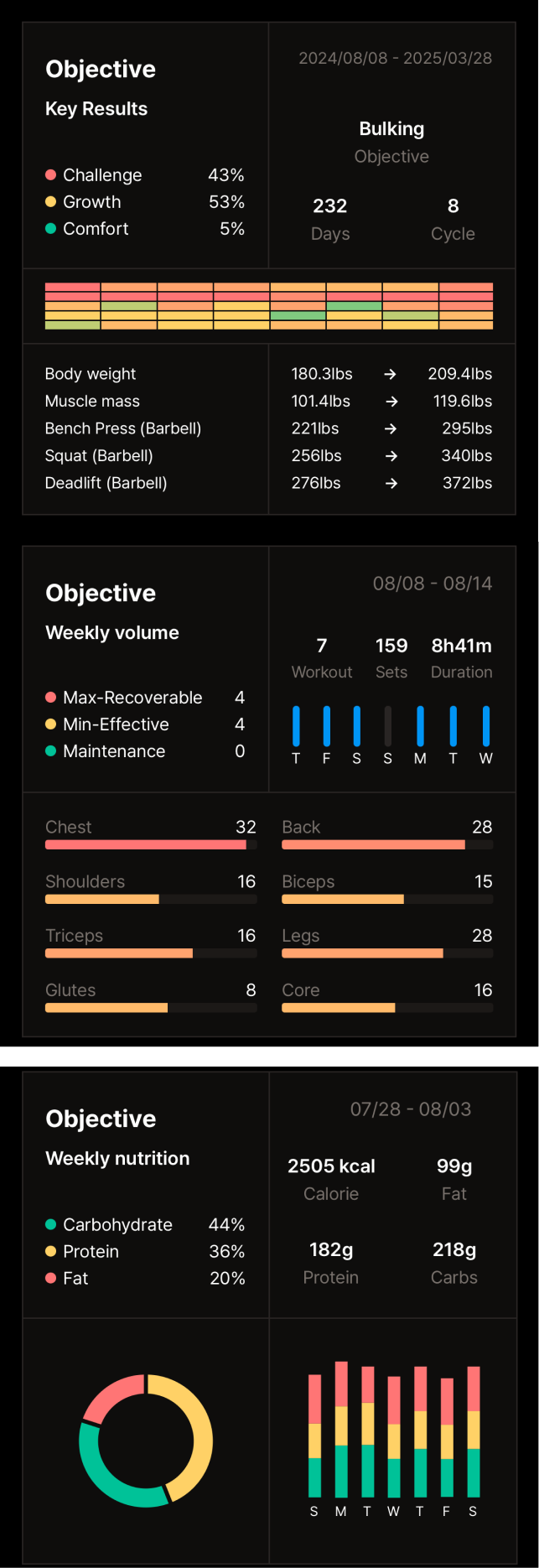Best Macro Ratios for Bulking, Cutting & Maintenance
Best Macro Ratios: Tailoring Your Diet for Bulking, Cutting, and Maintenance
Imagine you're finally committed to transforming your body, but the endless advice on diet leaves you overwhelmed. Navigating the world of nutrition can feel like deciphering a secret code. One crucial aspect of successful body transformation is understanding macro ratios. This guide simplifies these concepts, providing practical insights into how to tailor your diet for bulking, cutting, and maintaining your physique. We'll explore the importance of macros in achieving specific body transformations like muscle gain, fat loss, and maintaining a healthy weight.
Understanding Macros: The Basics
What Are Macros?
Macronutrients, or macros, are the nutrients your body needs in large amounts to function properly. They are the building blocks of your diet and include proteins, carbohydrates, and fats. Think of them as the fuel, construction materials, and essential components for your body's engine. Each macro plays a distinct role in your overall health and fitness.
Why Do They Matter?
Each macro contributes differently to your body's needs. Protein is essential for building and repairing muscle tissue, think of it like the bricks for a house. Carbohydrates are your body's primary source of energy, like gasoline for a car. Fats, often misunderstood, are crucial for hormone production, cell function, and nutrient absorption. They act like the oil that keeps your engine running smoothly. A balanced meal containing all three macros, like grilled chicken (protein) with brown rice (carbohydrates) and avocado (fats), illustrates macros in action. 
Macro Ratios for Bulking
The Goal of Bulking
Bulking is a strategic approach to gaining muscle mass while minimizing fat gain. It involves consuming a caloric surplus, meaning you eat more calories than your body burns, to provide the energy and building blocks needed for muscle growth. This surplus fuels intense workouts and promotes muscle protein synthesis.
Optimal Macro Ratios for Bulking
A common macro breakdown for bulking is 40-60% carbohydrates, 25-35% protein, and 15-25% fats. This balance provides ample energy for workouts and sufficient protein for muscle repair and growth.
Protein Intake
Protein is paramount for muscle repair and growth during bulking. Aim for a protein intake of roughly 1 gram per pound of body weight. Excellent sources include lean meats, fish, poultry, eggs, dairy, and plant-based options like tofu and lentils. 
Carbohydrates for Energy
Carbohydrates are your primary energy source, fueling intense workouts and promoting muscle glycogen replenishment. Focus on complex carbohydrates like brown rice, quinoa, oats, and sweet potatoes, which provide sustained energy release. 
Fats for Hormonal Balance
Healthy fats play a vital role in hormonal balance, which is essential for muscle growth. Include sources like avocados, nuts, seeds, and olive oil in your diet. 
Practical Tips for Bulking
Meal planning and preparation are key to maintaining your macro ratios consistently. Prepare meals in advance to ensure you have readily available, macro-balanced options. A sample bulking meal plan could include oatmeal with protein powder and berries for breakfast, chicken breast with brown rice and broccoli for lunch, and salmon with sweet potato and asparagus for dinner.
Macro Ratios for Cutting
The Goal of Cutting
Cutting focuses on reducing body fat while preserving as much muscle mass as possible. This involves consuming a caloric deficit, meaning you consume fewer calories than your body burns, forcing it to utilize stored fat for energy.
Optimal Macro Ratios for Cutting
A typical macro breakdown for cutting is 40-50% protein, 20-30% carbohydrates, and 30-40% fats. The higher protein intake helps maintain muscle mass during the caloric deficit. The increased fat ratio helps with satiety and hormone regulation during reduced calorie intake.
High Protein Focus
Prioritizing protein during a cutting phase helps prevent muscle loss while your body utilizes fat stores for energy. Opt for lean protein sources like chicken breast, turkey, fish, and Greek yogurt. 
Controlled Carbs for Fat Loss
While reducing carbs is common during cutting, they still play a role in sparing muscle and providing energy. Focus on low-glycemic index foods like vegetables, berries, and whole grains, which provide a slower, more sustained energy release. 
Essential Fats
Healthy fats promote satiety, support hormone production, and contribute to overall well-being. They are particularly important during a cutting phase to help manage hunger and maintain hormonal balance. Include sources like avocados, nuts, and seeds in your cutting diet. 
Practical Tips for Cutting
Strategies like meal timing and portion control become crucial during a cutting phase. Consuming smaller, more frequent meals can help manage hunger and maintain energy levels. A sample cutting meal might include scrambled eggs with spinach for breakfast, a grilled chicken salad with mixed greens and a light vinaigrette for lunch, and baked cod with steamed broccoli and a small portion of quinoa for dinner.
Macro Ratios for Maintenance
The Goal of Maintenance
Maintenance focuses on sustaining your current weight and body composition. This involves consuming a balanced caloric intake that matches your energy expenditure.
Optimal Macro Ratios for Maintenance
A common macro breakdown for maintenance is 40% carbohydrates, 30% protein, and 30% fats. This balanced approach supports overall health, energy levels, and muscle recovery.
Balanced Protein, Carbs, and Fats
Maintaining a balanced intake of all three macros is crucial for sustained energy levels, muscle recovery, and overall well-being. Flexible eating, or allowing for some dietary flexibility within your macro targets, can be a sustainable approach to maintenance.
Tips for Maintaining Weight
Regularly monitoring your intake and adjusting your macros as needed are key to maintaining your weight and physique. Pay attention to your body's signals and adjust your calorie and macro intake accordingly. A sample maintenance meal plan could include Greek yogurt with fruit and granola for breakfast, a turkey sandwich on whole-wheat bread with a side salad for lunch, and lean ground beef stir-fry with brown rice and mixed vegetables for dinner.
Customizing Your Macro Plan
Personalizing Your Ratios
Individual factors like activity level, metabolism, and specific goals influence your ideal macro ratios. A highly active individual may require more carbohydrates than someone with a sedentary lifestyle.
Using Macro Calculators
Online macro calculators can provide a starting point for determining your personalized macro targets. These calculators take into account factors like your age, weight, height, activity level, and goals.
Adjusting Macros Based on Progress
Monitor your progress and adjust your macro plan as needed. If you're not seeing the desired results, consider tweaking your ratios or consulting a registered dietitian or certified nutritionist for personalized guidance.
Conclusion
Choosing the right macro ratios is essential for achieving your fitness goals. Whether you're aiming to bulk up, lean down, or maintain your physique, understanding the roles of proteins, carbohydrates, and fats empowers you to tailor your diet effectively. Experiment, adjust, and find the macro balance that works best for you. Continue learning about nutrition by exploring related topics like micronutrients and their role in a balanced diet. By understanding and applying these principles, you can take control of your nutrition and reach your fitness aspirations.

